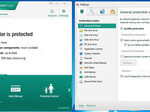An Example of Denial of Service
Imagine there is a concert with a very popular artist and band. The tickets have sold out. The weather is expected to be good that evening, and people are anxiously waiting for the concert to start. So they show up at the gates waiting to get in.
But they notice that even though there are 15 gates available to collect tickets, only one is manned to actually collect the tickets. So, the line grows longer and longer. People are impatient. The gatekeeper performs his duty in an efficient and timely manner, but it takes time to process the ticket. Meanwhile, the concert is about to start. People are left out in line and cannot get in.
That is denial of service.
At the computer or network level, the process is similar.
Operating System Attacks
Operating systems have flaws, not intentionally, but the structure of the OS may create some vulnerabilities. For instance, an operating system has to process different states of operation to work with memory and the CPU; this may leave the operating system open and vulnerable while it looks for the correct code to use in an operation. That is all the time that some viruses may need to exploit the vulnerability. Hackers look for them and pursue them if found. There are several denial of service attack examples for you to consider.
Remote Takeover
One such vulnerability is a weakness that allows a hacker to enter the system and take it over remotely. Once the takeover takes place, even without the computer user knowing about it, the hacker can operate.
Lockouts Using Authentication Controls
As shown in the beginning example, lockouts are possible, even in computer systems. Many systems have authentication features, such as a login name and password. Then, if a user enters the wrong password several times, the authentication control limits the attempts and can lock out the user. So a hacker can manipulate the login account limit and lock out the user.
Networking Attacks Affecting Entrance or Creating Speed Issues
DoS attacks can also affect networks. One example deals with the physical destruction or alteration of network components. Hackers can disrupt the connections between two computers or the disruption will occur among the multiple devices on the network. One way to do this is to flood the bandwidth with additional unneeded traffic. Legitimate traffic will not be able to enter or if it does, it travels at a reduced speed.
Non-Renewable Resources
DoS attacks can also consume scarce, limited or non-renewable resources. One example of a denial of service attack comes with the destruction or alteration of configuration information in the operating system. With such an attack, flooding occurs so the system is incapable of performing the normal operations. The CPU may be performing at the 100% level, which prevents other processes from running.
Memory Saturation
Another DoS example comes when programs access more and more memory thereby filling up the available space in the system. Generating excess mail messages may take up memory. This slows the system down, even to the point that other programs cannot run. Even after a re-boot, the problem may not go away. In such a case, the DoS attack now comes under the category of malware that has infected the system.
These examples can help individuals understand what problems may be affecting their systems. But note, every computer or network system is vulnerable. This is especially so if one is accessing the Internet. So PC users, network managers and administrators must create and enforce firewalls and setup controls to keep their systems as safe and protected as possible; knowing what DoS acts like is one way of setting up these controls.



